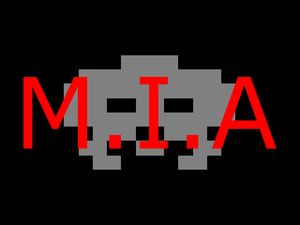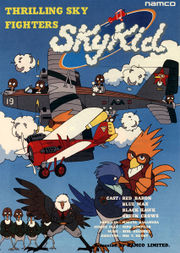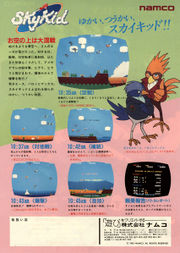Lost In Translation/Sky Kid
| Sky Kid | |
|---|---|
| Manufacturer | Namco |
| Released | 1985 |
| Control Method |
8-way Joystick 2 Button(s) |
| Main CPU | M6809 (@ 1.536 MHz) HD63701 (@ 1.536 MHz) |
| Sound CPU | Mono Namco CUS30 (@ 24.000 kHz) |
| Video Details |
Raster (Horizontal) 288 x 224 pixels 60.61 Hz 256 Palette colours |
| Screens | 1 |
| ROM Info | 14 ROMs 112,384 bytes (109.75 KiB) |
| MAME ID | skykid · skykidd · skykido |
About The Game
Sky Kid is an arcade video game shoot-em-up.
You play as the character Sky Kid. Sky Kid flies around in a bi-plane and is assigned specific targets during the missions. These missions involved bombing specific targets. This would seem easy, however, there are a few obstacles Sky Kid must overcome to get to the target safely. First, the bi-plane is not equipped with the bomb. Sky Kid must pick up the bomb en route to the target. Second, there are both ground and air units that attempt to keep Sky Kid from accomplishing his mission. Last, Sky Kid may have to navigate through some very inhospitable terrain or navigate around cities in order to get to the target. The targets that Sky Kid must bomb will either be a fortress complex or a ship. As one moves farther up in the missions, it isn't uncommon to have multiple targets in one mission. Perhaps barnstorming would have been a better idea.
Additional Technical Information
Players : 2
Control : 8-way joystick
Buttons : 2 (FIRE, LOOP)
Trivia
Released in December 1985.
After Namco ended its partnerships with both Midway and Atari, they started to release games in the United States. Releases such as "Gaplus", "Galaga 3", and "Dig Dug II" were some games that Namco released. Since the big arcade collapse of the early 80's had claimed quite a few arcade companies, Namco managed to fill the gap. Sky Kid was a game that didn't enjoy great success in the United States. The game, however, did show that Namco was on the right track as far as games they released. Featuring cartoon-like graphics and different types of missions, Sky Kid would form the basis of several other Namco games based on the same type of game-play. To this day, Namco is either releasing new arcade games or it is releasing old classics for the different gaming systems.
Sky Kid is the first game from Namco to allow play for two players simultaneously.
Scoring
Scoring in this game is kind of complicated. You get points for destroying air and ground targets. You then get additional points for how many of these types of targets you destroyed. In addition, you get points based on how much of the target you destroyed.
| Target | Points |
|---|---|
| Truck | 100 |
| Tank | 200 |
| AA Gun | 100 |
| Target | Points |
|---|---|
| AA Boat | 100 |
| Submarine | 100 |
| Target | Points |
|---|---|
| Planes | 100 |
| Balloon | 100 |
| Bomber | 100 |
| Bomb | 100 |
| Type | Points |
|---|---|
| Direct hit, target totally destroyed | 1,000 |
| Indirect hit, target partially destroyed | 500 |
You will receive a bonus after you land. This bonus depends on how many of each type of the above targets you destroyed. It is listed in the order of :
- Ground and Sea Units
- Air Units
- Mission Target or Targets
For the first two items, the scoring is:
| Units Destroyed | Points |
|---|---|
| 10-19 | 1,000 |
| 20-29 | 3,000 |
| 30-39 | 5,000 |
| 40-49 | 10,000 |
| 50 and UP | 20,000 |
In regard to targets, bonus points are scored on whether you totally destroy or partially destroy the target or targets:
| Type | Points |
|---|---|
| Partial Destruction | 2,000 |
| Total Destruction | 10,000 |
You will also get 10 points per second that you are in the air.
Tips and tricks
- When you start the game, Sky Kid will be at his airfield in the lower right of the game screen. When the mission starts, you will take off from that airfield. Keep in mind, this is a scrolling game. This means you can go no faster then the left side and no slower then the right side. You can, however, vary your speed in-between by pushing the joystick back and forth. The biggest key in getting through this game is learning how to use the joystick to speed up and slow down because you will sometimes be put into some very tight areas that will require precision joystick control.
- Remember the controls on this game are not reversed. This means that this isn't like a normal plane where pushing up causes the plane to dive and pushing down causes the plane to rise. Instead, the directions of the joystick will be the direction of the plane.
- Everything that isn't air is hazardous to Sky Kid's plane. This means don't go flying through the forests, cities, or billboards or you will have one less plane.
- Ground units (except trucks) attack in two manners :
- The tanks just throw up a wave of bullets toward your plane. They aren't very precise but sometimes the volume is enough to knock your plane out of the sky.
- The anti-aircraft guns fire what is called a proximity fuzed shell. These types of shells don't have to directly hit the plane to be lethal. Instead, they explode at a pre-set altitude and throw shrapnel in different directions. If Sky Kid's plane gets caught by any of this shrapnel, the plane is lost.
- The sea units also attack in two manners :
- The anti-aircraft boats throw the 'proximity' fuzed shell.
- Submarines throw up a wave of bullets then rapidly submerge.
- Enemy fighters will appear both from in front of and also behind Sky Kid. This basically means that hugging the left or right side of the screen is a bad thing since a collision is highly probable.
- Enemy fighters also seem to sense when Sky Kid's gunsights are locked on them. The enemy planes will do a loop and end up going in the opposite direction over Sky Kid. Keep this in mind when shooting at them since this could cause a collision.
- Just because Sky Kid's plane has been shot full of holes doesn't mean that all is lost. Once your plane has been shot, rapidly press the loop button and you may recover out of the shoot down. Of course, you need to do this right after you have been shot or it won't work.
- When Sky Kid is performing a loop, enemy units cannot hit him with fire. Of course, the disadvantage is that it puts Sky Kid at a higher altitude and it also may place him right in the way of an enemy air unit.
- During the first few missions, the bomb is relatively easy to get. As the missions progress, however, the bomb gets harder to retrieve. Sometimes it will be in a little spot between two trees or it may be at the bottom of a deep valley. Adjust speed and direction accordingly.
- Before you get to the bomb, a prompt 'GET THE BOMB' will appear on the screen a couple of seconds before the bomb gets into view.
- In order to fully destroy a target, you must plant your bomb right in the middle of it. You will know you have scored a direct hit because the target will explode and then sink.
- Speaking of targets, they are usually heavily defended. Not just by the outside units, but also by the volume of fire they can throw skyward to shoot down your plane.
- When you are approaching your airfield to land, make sure that you aren't in one of your enemy's gunsights. Enemy units sometimes will fire on you until you get on the runway. Nothing like almost getting to the airfield only to get shot down.
- As the missions progress, the distances also get longer. You will know how far you are when the prompt 'HALFWAY POINT' shows up on the screen. If you get shot down before the halfway point, you start from the airfield. If it is after the halfway point, you start from the halfway point.
- If you shoot the dancing girls around the airfield when you are coming in, they turn into pink flowers. Not worth any points but I guess a great way to line up your gunsights.
- If you overshoot the runway, you will run out of fuel and crash. You still, though, get the extra bonuses but you lose a plane in the process.
- Make sure you watch the terrain at all times. Sometimes mountains, billboards, cities, etc. will appear at the worst possible times. Of course, you can also use these to your advantage since enemy air units also get destroyed by these features
Series
- Sky Kid (1985)
- Sky Kid Deluxe (1986)
- Vs. Super Sky Kid (1986)
Staff
- Music By
- Junko Ozawa
Cabinet and Artwork
Ports
- Consoles
- Nintendo Famicom (1986)
- Sony PlayStation (1998, "Namco Museum Encore") (Japanese only)
- Sony PlayStation 2 (2005, "Namco Museum 50th Anniversary")
- Microsoft XBOX (2005, "Namco Museum 50th Anniversary")
- Nintendo GameCube (2005, "Namco Museum 50th Anniversary")
- Computers
- PC [MS Windows, CD-ROM] (2005, "Namco Museum 50th Anniversary")
Soundtrack Releases
| Album Name | Catalogue No. | Released | Publisher | Comments |
|---|---|---|---|---|
| Namcot Game a la Mode | VDR-1285[1] | 1986-09-21 | Victor Musical Industries | CD version. |
| Namco Video Game Graffiti | VDR-1165[2] | 1986-03-21 | Victor | CD version. |
| Namco Video Game Graffiti | VCH-10334[3] | 1986-03-21 | Victor | Cassette version. |
| Namco Video Game Graffiti | SJX-30291[4] | 1986-03-21 | Victor | Vinyl version. |
| Namcot Game a la Mode | SJX-30312[5] | 1986-09-21 | Victor Musical Industries | Vinyl version. |
| Namcot Game a la Mode | VCH-10365[6] | 1986-09-21 | Victor Musical Industries | Cassette version. |
| Game Sound Museum ~Namcot~ S2 Babel / Sky Kid / Metro-Cross | SDEX-0051[7] | 2004-12-23 | Scitron | CD version. |
| Arcade Ambiance 1986 | N/A[8] | 2004-08-27 | Andy Hofle | Digital download only. |
References
- ↑ Namcot Game a la Mode (CD) at the VGMdb
- ↑ Namco Video Game Graffiti (CD) at the VGMdb
- ↑ Namco Video Game Graffiti (Cassette) at the VGMdb
- ↑ Namco Video Game Graffiti (Vinyl) at the VGMdb
- ↑ Namcot Game a la Mode (Vinyl) at the VGMdb
- ↑ Namcot Game a la Mode (Cassette) at the VGMdb
- ↑ Game Sound Museum ~Namcot~ S2 Babel / Sky Kid / Metro-Cross (CD) at the VGMdb
- ↑ Arcade Ambiance 1986 (Digital Download) at the VGMdb






